I’ve always wanted to sail in the Arctic. Some of my greatest pleasure in voyaging comes from the remarkable animals that share the earth with us. I love diving and never tire of the tropical creatures, but I’ve always wanted to spot a walrus, or narwhal, or polar bear. However, voyaging in Arctic conditions requires a boat with a tough hull. That was why we recently modified our boat’s hull with a special “armor belt.”
In the summer of 2013, I found myself purchasing a cutter that came as close as my wallet would allow to my dream boat. My husband Seth and I had sold our previous boat upon completing our circumnavigation in 2010, had quickly regretted it, and had been searching almost ever since for a replacement. We were picky, though. Our old boat had been a classic, but burly, glass reinforced plastic (GRP) vessel that sailed relatively fast for her displacement. We wanted our new boat to be equally beautiful, but preferably newer (we’d spent about 50 percent of our time while circumnavigating on restoration and repairs), preferably lighter, and with a fin rather than a full keel. In other words, we were looking for a Spirit of Tradition yacht, a difficult thing to find for sale second-hand.
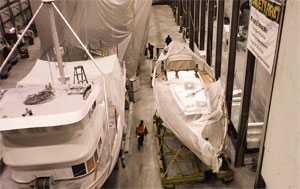 |
|
Celeste in Platypus Marine’s main shed in Port Angeles, Wash. |
Perseverance paid off, though, and in August 2013 we were the proud new owners of Celeste, a 1986 custom-built, cold-molded cutter designed by Francis Kinney and constructed by Bent Jespersen of British Columbia. Celeste was still in British Columbia, not too awfully far by voyaging standards from those walrus-strewn Arctic waters. Maybe we could even transit the Northwest Passage.
High-latitude refit
Celeste was due for her 25-year refit anyway, so why not expand it a little to make her ready for ice? We found the perfect boatyard for the job in Port Angeles, Wash. Platypus Marine builds and cares for a staggering variety of craft, from immaculate motor yachts to Coast Guard vessels, and had been recommended to us because of their excellent work on another classic sailboat.
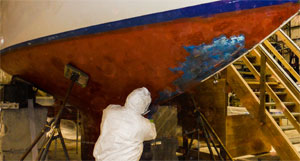 |
|
A worker strips Celeste’s cold molded wood hull. |
With Port Townsend and all its wooden boats just down the way, it might seem odd that we chose Platypus, but we needed a full-service yard with indoor storage for our diverse array of projects. Celeste needed a new diesel engine (we chose the Yanmar 3YM30) since her original auxiliary would cost just as much to rebuild as to replace. Equally important, Celeste’s hull was due for a new barrier coat. We had done that on our previous boat once osmosis started to show but wanted to do it to Celeste before it became a problem.
Remembering the six weeks we’d spent in Tyvek suits in 110° F heat grinding away the gel coat on our old boat, we were more than happy to hand over this project completely to the men at Platypus. Our project manager Stewart was experienced both with boating in ice (in Antarctica) and with cold-molded construction, so together we hashed out a plan. The outer layer of contemporary cold-molded boats is invariably fiberglass, protecting and strengthening the hull as well as making it easy to re-do the barrier coat 20 years hence. Wood, even if it’s cold-molded, cannot be soda-blasted, so stripping an older cold-molded boat’s gel coat requires scrapers and man-hours. This outer GRP layer is not at all the same thing as the questionable practice of sheathing a plank-on-frame wooden boat in fiberglass; cold-molded construction has everything to do with epoxy and nothing to do with caulking and fasteners and leaks. Celeste was built with three layers of cedar veneers, all saturated in epoxy resin and laid up at opposing angles, followed by a final layer of mahogany. Her hull requires no frames or fasteners to hold it together, does not soak up water, and is just as strong and stiff as a modern GRP yacht. In fact, it’s probably stronger given that it’s 1 1/4 inches thick, yet remains light thanks to the properties of wood.
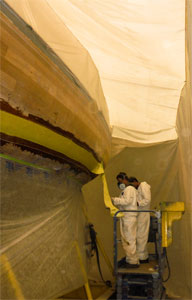 |
|
Adding the strip of Kevlar along the waterline as further protection against ice. |
Together with Stewart, Seth and I decided to have Celeste join the ranks of modern Spirit of Tradition yachts by adding two layers of GRP to the whole hull. Next time the barrier coat came due, it would be simple. The fiberglass would also give the hull extra protection against Arctic ice. Then Stewart told us about skim ice, which forms on the water’s surface in the small hours and cuts razor sharp through almost anything. We tossed around ideas about a stainless steel band at waterline and quickly rejected it on account of cost and looks. Instead we settled on a wide band of Kevlar, the material used to make bulletproof vests.
Into a heated shed
The first step was to strip the hull from keel to toerail of its old paint and gel-coat, bringing it back to the resin-soaked mahogany. Celeste’s rudder was dropped and her bow hardware removed to facilitate this. She was then put in a heated shed and surrounded by fans to dry out. Since this was the Pacific Northwest — not arid Australia where Seth and I had re-done our previous yacht’s gel-coat — Celeste needed several months in the shed.
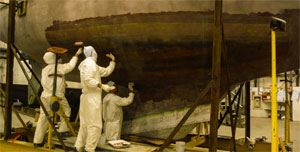 |
|
After the Kevlar armor, two layers of fiberglass above the waterline met with two layers coming up from the keel to provide a quadruple layer over the Kevlar. |
When the hull was bone dry, as tested by a moisture meter, it was in excellent condition; according to Stewart this was “due to the thinness of the multiple layers of varying direction,” which affirmed our faith in cold-molding. However, the fin keel, made of stacked mahogany above the lead, had revealed minor cracking from drying out. It wasn’t alarming, and Stewart’s team repaired it with dutchmen and splines. The only other crack was along the root of the rudder skeg, which they also repaired expertly.
Once all the repairs had been made and the through-hulls removed, Platypus Marine’s fiberglass department started work. They began with the Kevlar, painting the hull at waterline with resin and applying a strip of the magic cloth about a foot wide. Then came more resin, fairing compound and sanding to make it smooth. The team turned to the topsides next, affixing two layers of six-ounce boat cloth — suffusing them with resin — from the toerail down to about a foot below the Kevlar. They laid up a corresponding two layers of boat cloth from the keel’s lead to a foot above the Kevlar, creating a quadruple layer where the GRP overlapped around the waterline. The bow, the skeg, and the area of the hull between the keel and the skeg also received overlapping layers, doubling the amount of support.
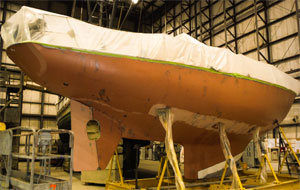 |
|
The hull swathed in fairing compound. |
Time for coatings
After two layers of epoxy fairing compound had been applied and sanded, it was time for the coatings system. The finish crew put on two coats of AwlGrip’s HullGard two-part primer over the entire hull, followed by High Build Epoxy Primer on the topsides.
In keeping with Platypus Marine’s standards, the paint department sanded the topsides with longboards to a perfectly smooth new-yacht finish despite our protests that she needn’t be a showboat! But the yard’s sales department honorably stayed on target with their estimate, even though they weren’t able to hold back the zealous paint team.
When all was ready — pinholes filled, edges of the paint detail-sanded — the topsides got three spray-applied coats of AwlGrip’s 545 Epoxy Primer to seal the surfacing primers. The team then did a final prep before spraying on the gorgeous white finish.
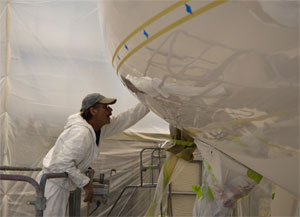 |
|
A worker finishes the topsides. |
Under the waterline, the HullGard was sanded and prepped for Interlux’s Interprotect 2000 gel coat. Where the Kevlar was the centerpiece of our ice defense, this two-part epoxy coat was the centerpiece of our osmosis prevention. Over this came two coats of red Sharkskin antifouling, a hard copper-based paint from Sea Hawk. Last to go on were two coats of blue hard bottom paint as a boot stripe. We chose bottom paint instead of topside paint here because we knew how loaded down Celeste would be with our Arctic gear.
The joinery department then re-installed our through-hulls and bow hardware, including a new 1-1/4-inch stainless steel bow iron, which came well below waterline, as one more precaution against skim ice. At the end of June 2014, we were ready to sail.
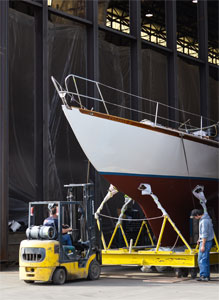 |
|
Celeste coming out of the shed at the end of the project. |
Unfortunately a number of factors combined to make a Northwest Passage transit impossible for us in 2014. That’s its own story, but briefly: Seth and I had left all the electrical work to do ourselves, anticipating only a few installations. As often happens, however, we discovered that every circuit needed replacement. Other setbacks on our project list mounted up and, despite working 12- to 14-hour days for a month, we found ourselves more than two weeks late starting for the Arctic and utterly exhausted. Not a safe recipe for tackling those latitudes. Instead of trying to make up time with an equally exhausting passage direct to the Bering Sea, we decided to explore Alaska.
The lack of polar bears was amply recompensed by the incredible array of humpback whales, orcas, brown bears, otters and birds populating the 49th state. In fact, Seth and I could hardly believe we had almost overlooked these unbeatable cruising grounds in our fervor to get north!
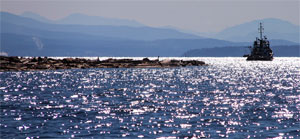 |
|
A log boom on the inside passage in British Columbia. |
Dealing with dead heads
Nor were we at all upset that we’d beefed up Celeste with Kevlar, GRP and a new barrier coat. The Inside Passage is known for log booms and consequently, huge driftwood. Some timbers become so waterlogged that they submerge as “dead heads.” Celeste hit one of these heavy, destructive and barely visible objects on our overnight passage from Haida Gwaii to Ketchikan. We were traveling at roughly 9 knots before a 20- to 25-knot southeasterly breeze; we heard a terrific bang, were terrified in turn, but discovered not even the slightest damage when we arrived in Ketchikan.
About a month later, we nosed through the ice field towards Columbia Glacier. This large tidewater glacier descends from 10,000 feet to the head of Prince William Sound. Icebergs calve off its terminal face and float down the inlet, making sailing somewhat hazardous and motoring tricky. Wanting to see this magnificent piece of nature, Seth and I brought Celeste as close as we could, dodging icebergs, bergy bits and growlers. We quit when we reached a point where the ice concentration was about six-tenths. There was a clear line between the bergy water that had been fairly open (save for one band of three-tenths concentration) and an ice field of six-tenths or more. The heavy ice looked deceptively navigable on the surface but we knew the bergs touched underwater. On our way to and from the glacier we made sure to keep a bow lookout, but we inevitably nudged a few growlers, especially in the band of three-tenths. Hard and abrasive as they were, however, they did no damage to our hull or even to our paint.
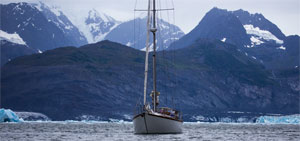 |
|
Celeste in Prince William Sound. |
We discovered an unexpected benefit of our hull project while battling volatile weather down the Alaska Peninsula. Slamming against head seas and consistent 40-knot contrary winds, flying only a high-cut Yankee jib, Celeste was still averaging 7 knots! Hitting that speed at all in our previous boat had been an event to celebrate. Seth and I then realized that Celeste — with only a 28-foot waterline — had been putting 9, 10, even 11 knots under the keel so often on this voyage that 5 knots felt like waddling. While part of this was attributable to the high winds we’d experienced, some of it was undoubtedly due to the added stiffness of the Kevlar and GRP layers; Celeste had been swift — but not this fast — before we’d entrusted her to Platypus Marine.
So while our Kevlar experiment was not tested this year in the sea ice of the Northwest Passage, it proved itself against dead heads and glacial growlers and produced the unexpected dividend of making Celeste a faster, stronger and stiffer boat than she was at her original construction. Someday Seth and I hope to see how fast we can make a trade wind crossing, and next summer we’ll try to find some arctic critters fishing from their ice floes. While we hope not to test the strength of Celeste’s hull too hard, knowing she can handle some abuse gives us peace of mind in any latitude.
Circumnavigator, writer, and photographer Ellen Massey Leonard most recently sailed from Washington State to the Aleutian Islands and plans to continue north in 2015. She was pleased to have Katadyn, Platypus Marine, Rolls Battery, OCENS Satellite Services, MVS Satellite Communications, ZEAL Optics, and Mantus Anchors agree to sponsor her Arctic voyage. The 28-year-old voyager chronicles her adventures at www.GoneFloatabout.com.
